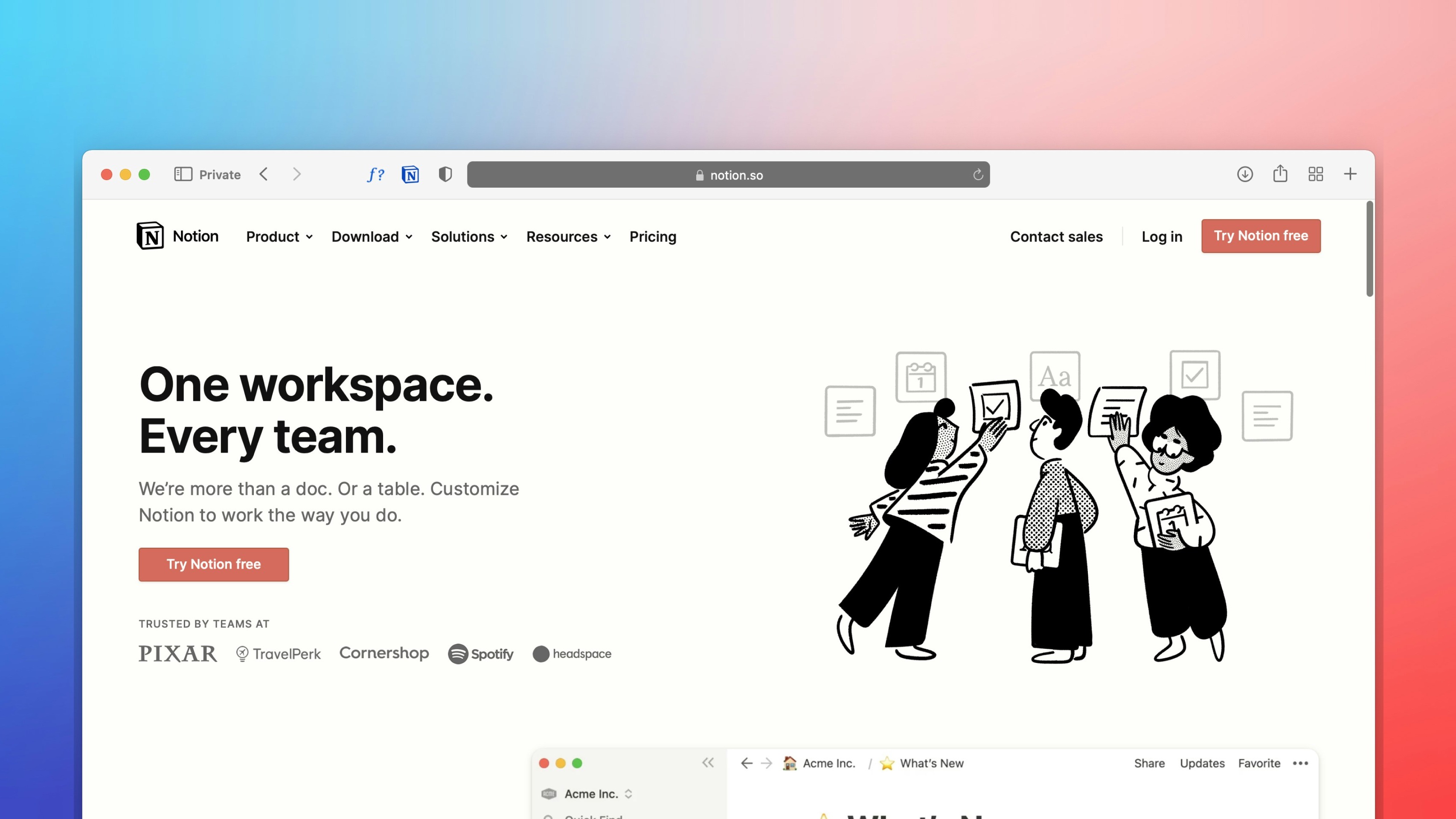 Freelancer tips
Freelancer tips Notion: What It Is, What It’s For, and How to Use It in Your Daily Life
Want to better organize your life and work? Notion can help boost your productivity. Click here to discover what this software is and what it’s used for.



Freelancing platforms are a popular choice for remote work, though, like everything else, they have their pros and cons. Today, we’re putting two rivals head-to-head: Upwork vs. Freelancer.com, two giants in the freelancing world.
However, choosing one to work on isn’t easy. There are many factors to consider, which is why you’re here. We’ve done the research to make it easier for you to decide which platform suits you better.
So, let’s look at what each platform offers and determine which is better for finding remote work.
Freelancer and Upwork both host millions of users, from companies to freelancers.
First, we have Freelancer.com, founded in 2009 as a global job marketplace aimed at helping small and medium businesses find specialists in various fields. As a freelancer, you can bid on projects and set your deadlines and rates. However, the platform uses a competitive model where other freelancers can bid on the same jobs, creating a competitive environment.
Today, Freelancer.com boasts over 50 million freelancers.
On the other hand, Upwork launched in 2015 to offer job opportunities to independent contractors. It provides both hourly and fixed-rate contracts that freelancers can apply for, depending on their interests.
Upwork operates using a “Connects” system, which are virtual tokens used to submit proposals. Each project requires a specific number of these tokens.
Upwork’s freelancer base has surpassed 12 million.
Online reviews of Upwork and Freelancer are often mixed, but Trustpilot remains one of the most reliable sites for freelancer platform reviews.
As of now, Freelancer.com has a higher Trustpilot rating than Upwork, with a 4.5/5 from 14,825 reviews. Positive feedback highlights the support team’s responsiveness and the broad range of projects. Negative reviews, however, often mention issues with arbitration, account restrictions, and fund management.
Freelancers appreciate Upwork for its intuitive platform and being a great choice for building a remote career. However, some express frustration with Upwork’s verification process and the fees, which are considered high by many. Additionally, Upwork’s customer service is often criticized for being slow to respond.
When it comes to fees, Freelancer.com and Upwork vary significantly.
How Much Does Freelancer.com Charge?
On many platforms, you don't have to pay to register, such as Freelancer and Fiverr. However, there are additional charges in case you want to highlight your offers or participate in contests.
Freelancer takes a commission based on the type of work you do. For example, for a fixed-price project, they take 10% or $5 USD, whichever is higher.
In case of a dispute, the platform charges a $5 or 5% fee to both parties. Freelancer.com also offers four paid subscription plans with increasing benefits based on the level.
Do You Need to Pay to Join Upwork?
No, you don’t need to pay. You can open an account, set up your profile, and search for jobs for free. Unlike Freelancer, Upwork takes a standard 10% commission per client on every completed contract.
For subscriptions, Upwork offers Freelancer Plus, and it also has the Preferred Freelancer Program, which charges fees for recruiter-managed projects.
Freelancers can also purchase additional “Connects” to increase their proposals’ visibility.
Before using any platform to search for remote work, it’s essential to evaluate their positives and negatives.
Here’s a comparison chart of Upwork vs. Freelancer, highlighting each platform's advantages and disadvantages:
Platform | Advantages | Disadvantages |
Upwork | Choose any projects you want. Access to major companies globally. Reliable payment system. Project management and tracking tools. | Strict application process. 10 free Connects per month with the basic plan. |
Freelancer.com | Easy to join and start working. Flexible membership options. Compete in contests and win prizes. Wide variety of projects, from short tasks to long-term contracts. | Fee required in case of disputes. May encounter fraudulent job listings. |
Many professionals can work from home on Upwork or Freelancer, given the variety of categories available for freelancers.
For those looking to build a solid base with regular clients, Upwork offers long-term projects. Freelancers can also take on specialized projects, like mobile development or technical writing, often with high-profile companies.
On Freelancer.com, freelancers can choose from various projects, including contests where you submit your solution to a specific project. There are also quick-turnaround projects.
Categories on Freelancer.com | Categories on Upwork |
Sales and Marketing. Writing. Translation. Business. Law. Health and Medicine. Telecommunications. Engineering and Science. | Sales and Marketing. Design and Creative. Translation. Administrative Support. Accounting and Consulting. Web, Mobile, and Software Development. IT and Networking. Engineering and Architecture. |
Both freelancer platforms use different methods to manage project listings.
On Freelancer.com, you can bid on projects, participate in contests, or access exclusive projects if you’re in the Preferred Freelancer Program. However, you may need to pay the service fee upfront before starting fixed-price projects. If you compete in a contest and don’t win, you won’t receive any payment.
On Upwork, you submit proposals using Connects, list your services, and even offer consultations. You can also accept direct invitations from clients or recruiters. Jobs are sorted by skills and industry on Upwork, allowing you to find relevant opportunities.
In essence, the primary difference lies in how projects are managed.
Which is Better, Upwork or Freelancer?
Check out the following chart to find out:
Aspect | Freelancer.com | Upwork |
Types of Clients | Small, medium, and large businesses. Entrepreneurs. | Entrepreneurs. Small and medium-sized enterprises. large companies. |
Types of Jobs | Hourly. Milestone contracts Contests. | Hourly. Project catalog. Consultations. Milestone contracts. Full-time. |
Job Applications | Bids based on membership level. Participating in contests. Working with platform recruiters. | Proposals using Connects. Responding to client invitations. |
This chart highlights key differences in job searching and project management on Upwork and Freelancer.com. Hopefully, it clarifies which one might be the best fit.
While we’ve covered this topic, here’s a straightforward look at Freelancer.com and Upwork fees:
Freelancer.com | Upwork | |
Registration | Free | Free |
Commissions | 10% or 5.00 USD per fixed project (whichever is higher). 10% per hour. 10% or 5.00 USD for winning contests (whichever is higher). | Flat rate of 10% per customer. |
Plans | Basic: $6.95/month. Plus: $8.95/month. Professional: $59.95/month. Premium: $119.95/month. | Freelancer Basic (free). Freelancer Plus: $14.99. |
Other Fees | Costs for highlighting offers. 15% derived from the Preferred Freelancer Program. Arbitration fees of 5.00 USD or 5% (whichever is higher). | Additional purchase of ‘Connects’. |
The platforms differ in how payments are managed.
Upwork uses an escrow system for fixed-price projects, where employers deposit funds upfront, and they’re only released upon project completion.
In Freelancer.com, payments go through a similar milestone-based system called Milestone Payments, which transfers funds upon project completion.
Upwork Payment Methods | Freelancer.com Payment Methods |
PayPal. Payoneer. ACH Transfer. Wire Transfer. | Skrill. Payoneer. PayPal. Bank Transfer. |
Note that commission fees may be high depending on the payment method chosen.
Looking for a more convenient option?
Consider DolarApp, as both Upwork and Freelancer pay freelancers in USD. With DolarApp, you can receive U.S. dollars, simplifying online transactions. Plus, by linking a peso account, you can seamlessly convert USD to MXN without additional fees and at the best exchange rate.
Upwork and Freelancer aren’t the only reputable freelancing platforms out there. Here are three popular options:
A globally popular platform for freelancers with a model based on Gigs or predefined services. You list what you offer, and clients buy directly without needing to post a project.
See more in our Upwork vs. Fiverr comparison.
While open to users worldwide, Workana is especially popular among Latin American freelancers. It’s an attractive alternative if you’re looking for projects in local markets.
Check out our comprehensive review on Upwork vs. Workana.
Unlike Upwork, Freelancer, Fiverr, and Workana, FlexJobs focuses on location- and schedule-flexible job listings, making it an excellent option for remote work. The platform connects you with companies offering long-term contracts, providing more stability. Check out more in our post on Upwork vs. FlexJobs.

The world has borders. Your finances don’t have to.
 Freelancer tips
Freelancer tips Want to better organize your life and work? Notion can help boost your productivity. Click here to discover what this software is and what it’s used for.

 Freelancer tips
Freelancer tips Project chaos? Learn how Trello can help you organize tasks and improve your productivity.

 Freelancer tips
Freelancer tips ClickUp can make any freelancer more productive. Discover what it is, how it works, and the advantages this tool offers you


